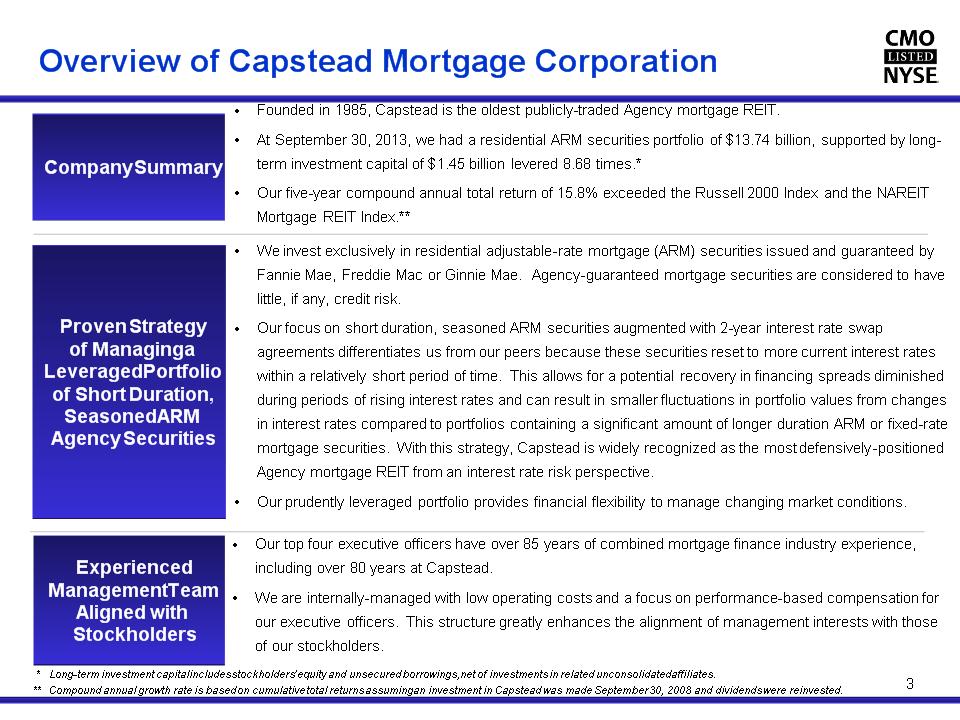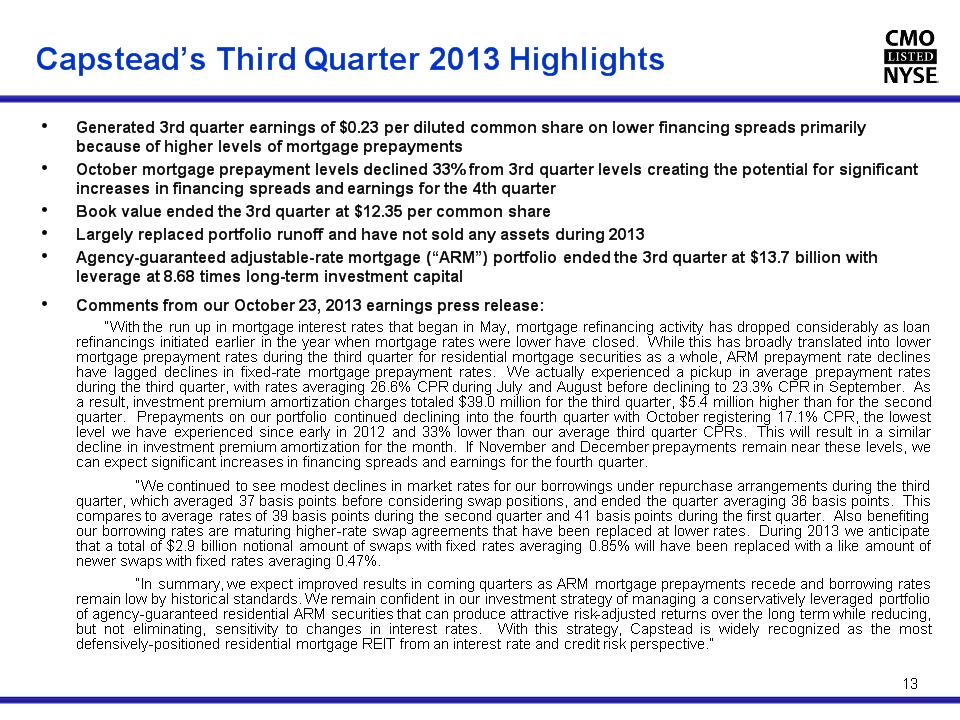Attached files
| file | filename |
|---|---|
| 8-K - CAPSTEAD MORTGAGE CORP 8-K 11-18-2013 - CAPSTEAD MORTGAGE CORP | form8k.htm |
Exhibit 99.1

CAPSTEAD Information as of September 30, 2013 Investor Presentation

Safe Harbor Statement - Private Securities Litigation Reform Act of 1995 Cautionary Statement Concerning Forward-looking Statements This document contains “forward-looking statements” within the meaning of the Private Securities Litigation Reform Act of 1995. Forward-looking statements include, without limitation, any statement that may predict, forecast, indicate or imply future results, performance or achievements, and may contain the words “believe,” “anticipate,” “expect,” “estimate,” “intend,” “will be,” “will likely continue,” “will likely result,” or words or phrases of similar meaning. Forward-looking statements are based largely on the expectations of management and are subject to a number of risks and uncertainties including, but not limited to, the following: In addition to the above considerations, actual results and liquidity are affected by other risks and uncertainties which could cause actual results to be significantly different from those expressed or implied by any forward-looking statements included herein. It is not possible to identify all of the risks, uncertainties and other factors that may affect future results. In light of these risks and uncertainties, the forward-looking events and circumstances discussed herein may not occur and actual results could differ materially from those anticipated or implied in the forward-looking statements. Forward-looking statements speak only as of the date the statement is made and the Company undertakes no obligation to update or revise any forward-looking statements, whether as a result of new information, future events or otherwise. Accordingly, readers of this document are cautioned not to place undue reliance on any forward-looking statements included herein. changes in general economic conditions; fluctuations in interest rates and levels of mortgage prepayments; the effectiveness of risk management strategies; the impact of differing levels of leverage employed; liquidity of secondary markets and credit markets; the availability of financing at reasonable levels and terms to support investing on a leveraged basis; the availability of new investment capital; the availability of suitable qualifying investments from both an investment return and regulatory perspective; changes in legislation or regulation affecting Fannie Mae and Freddie Mac (together, the “GSEs”) and similar federal government agencies and related guarantees; other changes in legislation or regulation affecting the mortgage and banking industries; changes in market conditions as a result of Federal Reserve monetary policy or federal government fiscal challenges; deterioration in credit quality and ratings of existing or future issuances of GSE or Ginnie Mae Securities; changes in legislation or regulation affecting exemptions for mortgage REITs from regulation under the Investment Company Act of 1940; and increases in costs and other general competitive factors. 2

Company Summary Proven Strategy of Managing a Leveraged Portfolio of Short Duration, Seasoned ARM Agency Securities Experienced Management Team Aligned with Stockholders Overview of Capstead Mortgage Corporation Founded in 1985, Capstead is the oldest publicly-traded Agency mortgage REIT. At September 30, 2013, we had a residential ARM securities portfolio of $13.74 billion, supported by long-term investment capital of $1.45 billion levered 8.68 times.* Our five-year compound annual total return of 15.8% exceeded the Russell 2000 Index and the NAREIT Mortgage REIT Index.** We invest exclusively in residential adjustable-rate mortgage (ARM) securities issued and guaranteed by Fannie Mae, Freddie Mac or Ginnie Mae. Agency-guaranteed mortgage securities are considered to have little, if any, credit risk. Our focus on short duration, seasoned ARM securities augmented with 2-year interest rate swap agreements differentiates us from our peers because these securities reset to more current interest rates within a relatively short period of time. This allows for a potential recovery in financing spreads diminished during periods of rising interest rates and can result in smaller fluctuations in portfolio values from changes in interest rates compared to portfolios containing a significant amount of longer duration ARM or fixed-rate mortgage securities. With this strategy, Capstead is widely recognized as the most defensively-positioned Agency mortgage REIT from an interest rate risk perspective. Our prudently leveraged portfolio provides financial flexibility to manage changing market conditions. Our top four executive officers have over 85 years of combined mortgage finance industry experience, including over 80 years at Capstead. We are internally-managed with low operating costs and a focus on performance-based compensation for our executive officers. This structure greatly enhances the alignment of management interests with those of our stockholders. 3 * Long-term investment capital includes stockholders’ equity and unsecured borrowings, net of investments in related unconsolidated affiliates. ** Compound annual growth rate is based on cumulative total returns assuming an investment in Capstead was made September 30, 2008 and dividends were reinvested.

Market Snapshot (dollars in thousands, except per share amounts) 4 On October 18, 2013 we paid a $0.31 3rd quarter dividend; unchanged from the 1st and 2nd quarters. In June 2013 we redeemed high-cost (over 11%) preferred capital with proceeds from our May 2013 7.50% Series E issuance ($170 face amount) and $43 million in cash on hand, lowering annualized preferred dividend requirements by $8.3 million, or nearly $0.09 per common share. We recently implemented a 7.50% Series E at-the-market, continuous offering program in order to issue a small amount of new Series E preferred shares in the coming quarters, subject to compliance with federal securities laws, market conditions, and blackout periods associated with the dissemination of important Company-specific news. (*) As of September 30, 2013.

Capstead’s Prudent Use of Leverage 5 ** Borrowings under repurchase arrangements divided by long-term investment capital. ($ in millions) Portfolio Leverage* Long-Term Investment Capital $100 $164 $1,189 Common Stock Preferred Stock Trust Preferred Securities, net Portfolio leverage ended the 3rd quarter of 2013 at 8.68 times long-term investment capital. Leverage increased during 2013 because of the 2nd quarter redemption of higher-cost preferred capital with proceeds of issuing a lesser amount of new 7.50% Series E preferred shares and $43 million of cash on hand, as well as portfolio and hedge instrument runoff and pricing declines since year-end. In our view, borrowing at current levels represents an appropriate and prudent use of leverage for an agency-guaranteed ARM securities portfolio in today’s market conditions.

Capstead’s Proven Short-Duration Investment Strategy 6 As of September 30, 2013 As of September 30, 2013 Low risk agency-guaranteed residential ARM securities financed primarily with 30-90 day “repo” borrowings, augmented with two-year interest rate swap agreements for hedging purposes. We replaced nearly all of our portfolio runoff and did not sell any assets or dramatically alter our hedge positions during the first three quarters of 2013 despite recent increases in interest rates. Further, our book value declined by only 6.3% during this period due to portfolio and hedge instrument runoff and portfolio pricing declines. This performance far exceeds that of nearly all of our mortgage REIT peers and validates our short-duration investment strategy. Residential ARM Securities Portfolio Repurchase Arrangements & Similar Borrowings Total: $12.62 billion Total: $13.73 billion Our securities are typically backed by seasoned mortgage loans with coupon interest rates that are currently resetting to more current rates at least annually or will begin doing so in five years or less. We have long-term relationships with numerous lending counterparties. At quarter-end, we had borrowings outstanding with 23 counterparties. 3rd quarter 2013 unhedged borrowing rates averaged 37 basis points, down from 39 basis points during the 2nd quarter of 2013 (a blended rate of 0.49% after considering currently-paying interest rate swaps). At quarter-end, we held $3.80 billion notional amount of currently-paying two-year term interest rate swaps requiring fixed rate payments averaging 0.57% with average maturities of 11 months. Also held at quarter-end was $3.30 billion notional amount of forward-starting swaps that will begin requiring fixed rate payments averaging 0.48% for two-year terms beginning on various dates between October 2013 and April 2014. The duration of our investment portfolio and related borrowings (adjusted for swap positions) was approximately 12 months and 10¼ months, respectively, at quarter-end. This resulted in a net duration gap of approximately 1¾ months. Duration is a measure of market price sensitivity to interest rate movements. Longer-to-Reset ARMs $6.10 Billion Current-Reset ARMs $7.63 Billion Borrowings with rates effectively fixed by Currently-Paying Interest Rate Swaps $3.80 Billion Remaining Borrowings $5.52 Billion* Forward-starting Interest Rate Swap Positions $3.30 Billion 30% * Borrowing rates on $8.82 billion, or 70%, of our borrowings at quarter-end were unaffected by our swap positions.

Financing Spread Analysis As of September 30, 2013 (unaudited) 7 Changes in mortgage prepayment levels and resulting changes in investment premium amortization drive changes in our portfolio yields and financing spreads and ultimately our earnings. After increasing during the 2nd quarter and into the 3rd quarter, prepayments began declining in September and fell dramatically to 17.1% CPR for October, a level not seen since early in 2012. Unhedged borrowing rates have continued to decline modestly during 2013 and we continue to benefit from the expiration of higher rate swaps. In summary, we expect improved results in coming quarters if these trends continue.

Agency Mortgage Prepayment Speeds versus Capstead Prepayment Speeds 8 Published Agency Prepayment Speeds vs. CMO Prepayment Speeds (in CPR) While overall prepayment speeds for agency-guaranteed mortgage securities declined since June in response to sharp increases in mortgage interest rates, speeds for ARM securities have lagged declines for 30-year fixed-rate securities. Our prepayment speeds actually increased early in the 3rd quarter before beginning to decline in September. Our speeds declined significantly in October to 17.1% CPR, to a level 33% lower than our average 3rd quarter speeds.

* Net WAC, or weighted average coupon, is the weighted average interest rate of the mortgage loans underlying the indicated investments, net of servicing and other fees, as of September 30, 2013. Net WAC is expressed as a percentage calculated on an annualized basis on the unpaid principal balance of the mortgage loans underlying these investments. Fully indexed WAC represents the weighted average coupon upon one or more resets using interest rate indexes and net margins in effect as of September 30, 2013. Gross WAC is the weighted average interest rate of the mortgage loans underlying the indicated investments, including servicing and other fees paid by borrowers, as of September 30, 2013. NOTE: Excludes $7 million of fixed-rate investments. Key Elements of Capstead’s ARM Portfolio As of September 30, 2013 (dollars in thousands, unaudited) 9

Interest Rate Swap Agreement Rollforward As of September 30, 2013 (dollars in thousands, unaudited) 10 To help mitigate exposure to higher interest rates, Capstead typically uses currently-paying and forward-starting one- and three-month LIBOR-indexed, pay-fixed, receive-variable, interest rate swap agreements with two-year payment terms. In the current environment, this is resulting in declining hedge costs as higher rate swaps expire and are replaced at lower rates. * Based on the difference between fixed swap rates of expiring contracts and existing contracts as of September 30, 2013 that begin two-year terms during the indicated periods excluding differences between LIBOR-based variable rate payments received under swap contracts and unhedged borrowing rates as well as the effects of any hedge ineffectiveness. There can be no assurance interest rate swap agreements entered into subsequent to quarter-end will have fixed swap rates at the indicated levels.

Capstead’s Stockholder Friendly Structure 11 * Expressed as a percentage of average long-term investment capital (LTIC). ** Incentive compensation for the third quarter reflects the estimated year-to-date effect of recently adopted changes to our short-term incentive compensation program. The new program determines levels of incentive compensation based on a number of relative performance metrics measured against our mortgage REIT peers. For the nine months ended September 30, 2013, our operating costs as a percentage of long-term investment capital are still lower than that of our mortgage REIT peers. Internally-managed with low operating costs. Our board of directors and our senior executives are required to hold a significant amount of Capstead stock. Our executives’ pay structure is variable through compensation elements that focus on “pay for performance” as opposed to fees paid to an external manager that are based solely on capital under management. As a result, our executives are incented to grow the Company by raising capital only when it is accretive to book value and earnings rather than for the purpose of increasing compensation or external management fees.

CAPSTEAD Appendix CAPSTEAD 12

Capstead’s Third Quarter 2013 Highlights Generated 3rd quarter earnings of $0.23 per diluted common share on lower financing spreads primarily because of higher levels of mortgage prepayments October mortgage prepayment levels declined 33% from 3rd quarter levels creating the potential for significant increases in financing spreads and earnings for the 4th quarter Book value ended the 3rd quarter at $12.35 per common share Largely replaced portfolio runoff and have not sold any assets during 2013 Agency-guaranteed adjustable-rate mortgage (“ARM”) portfolio ended the 3rd quarter at $13.7 billion with leverage at 8.68 times long-term investment capital Comments from our October 23, 2013 earnings press release: “With the run up in mortgage interest rates that began in May, mortgage refinancing activity has dropped considerably as loan refinancings initiated earlier in the year when mortgage rates were lower have closed. While this has broadly translated into lower mortgage prepayment rates during the third quarter for residential mortgage securities as a whole, ARM prepayment rate declines have lagged declines in fixed-rate mortgage prepayment rates. We actually experienced a pickup in average prepayment rates during the third quarter, with rates averaging 26.6% CPR during July and August before declining to 23.3% CPR in September. As a result, investment premium amortization charges totaled $39.0 million for the third quarter, $5.4 million higher than for the second quarter. Prepayments on our portfolio continued declining into the fourth quarter with October registering 17.1% CPR, the lowest level we have experienced since early in 2012 and 33% lower than our average third quarter CPRs. This will result in a similar decline in investment premium amortization for the month. If November and December prepayments remain near these levels, we can expect significant increases in financing spreads and earnings for the fourth quarter. “We continued to see modest declines in market rates for our borrowings under repurchase arrangements during the third quarter, which averaged 37 basis points before considering swap positions, and ended the quarter averaging 36 basis points. This compares to average rates of 39 basis points during the second quarter and 41 basis points during the first quarter. Also benefiting our borrowing rates are maturing higher-rate swap agreements that have been replaced at lower rates. During 2013 we anticipate that a total of $2.9 billion notional amount of swaps with fixed rates averaging 0.85% will have been replaced with a like amount of newer swaps with fixed rates averaging 0.47%. “In summary, we expect improved results in coming quarters as ARM mortgage prepayments recede and borrowing rates remain low by historical standards. We remain confident in our investment strategy of managing a conservatively leveraged portfolio of agency-guaranteed residential ARM securities that can produce attractive risk-adjusted returns over the long term while reducing, but not eliminating, sensitivity to changes in interest rates. With this strategy, Capstead is widely recognized as the most defensively-positioned residential mortgage REIT from an interest rate and credit risk perspective.” 13

Capstead’s Condensed Quarterly Income Statements (dollars in thousands, except per share amounts, unaudited) 14 Includes $2.1 million in interest charges on unsecured borrowings net of related earnings of related unconsolidated affiliates. With the issuance of our new 7.50% Series E preferred shares, and subsequent redemption of our existing preferred shares, cash dividends paid on preferred shares has been reduced on an annualized basis by $8.3 million, or nearly $0.09 per common share. Second quarter 2013 net income available to common stockholders reflects a short-term preferred capital “overhang” associated with the timing difference between the May 13, 2013 issuance of our Series E preferred shares and the June 13, 2013 redemption of our existing preferred shares as well as a one-time charge of $19.9 million associated with the payment of Series A and B redemption preference premiums. Core earnings per common share, a non-GAAP financial measure, excludes the effects of these items. See page 17 for further information regarding this non-GAAP financial measure.

Capstead’s Comparative Balance Sheets (dollars in thousands, except per share amounts, unaudited) 15

Capstead’s Annual Income Statements – Five Years Ended 2012 (dollars in thousands, except per share amounts, unaudited) 16 * See page 17 for further information regarding this non-GAAP financial measure.

Non-GAAP to GAAP Reconciliation of Financing Spreads As of September 30, 2013 (unaudited) 17 Financing spreads on residential mortgage investments, a non-GAAP financial measure, differs from total financing spreads, an all-inclusive GAAP measure that is based on all interest-earning assets and all interest-paying liabilities. We believe that presenting financing spreads on residential mortgage investments provides useful information for evaluating the performance of the Company’s portfolio.

